今天分享的这篇论文发表时间是2012年,算是比较早了,是把深度卷积神经网络成功应用在计算机视觉领域的开山之作,目前被引用量接近 70000,可见影响力非常之大,可以说做视觉的论文十有八九会引用它。网络上对它的讲解非常之多,再拿出来阅读,是因为它很经典,搞清楚深度卷积神经网络一些最基本的东西。
-
论文标题:ImageNet Classification with Deep Convolutional Neural Networks
-
论文作者:Alex Krizhevsky, Ilya Sutskever, Geoffrey E. Hinton(多伦多大学)
-
收录情况:NIPS 2012
这篇论文提出的神经网络被称为 AlexNet,它的成名源于一个视觉识别竞赛 ImageNet Large Scale Vision Recognition Challenge (ILSVRC)——2010年开办,每年一次,2017年年结束。ImageNet是一个计算机视觉领域的公开数据集,规模非常之大——涵盖22000个类别的1500万张标注图片,目的是让研究人员的算法在上面做实验,
- Image Classification
- Object Detection
- Semantic Segmentation
比较不同算法的优劣,促进视觉研究的进步。ILSVRC 使用的是 ImageNet 的一部分数据,包含~120万张图片,分成1000类,每类~1200张图片,划分成训练集(100万张标注图片)、验证集(5万张标注图片,用于自己评估算法效果)、测试集(15万张无标签图片,预测结果提交到主办方评估)参赛者需要开发算法把测试集图片分到正确的类别。这其实是个比较困难的任务。
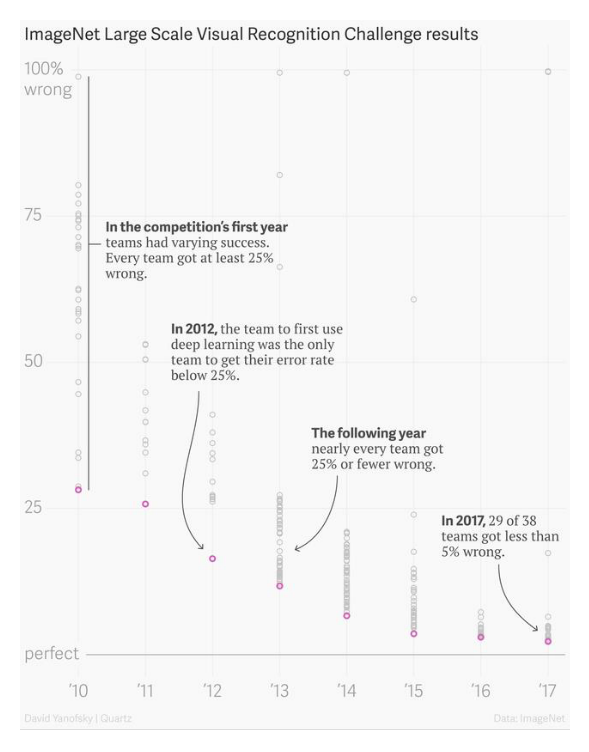
简介
- AlexNet 是一个8层的神经网络,5个卷积层 + 3个全连接层
- 几个创新点 —— 现在看来是 tricks:
- 激活函数使用 ReLU
- 分布式训练 —— 使用了两块GPU
- 使用 Normalization
- 使用 Overlapping Pooling
- Dropout 应用到了全连接层
- 现在看似很简单,实际上经历了长期探索
相关工作
作者论文里没单独写相关工作这一章,但是在实验部分与几个方法图片识别方法对比了,可能是当时把这些方法写成论文的很少,简单介绍一下它们
- A. Berg, J. Deng, and L. Fei-Fei. Large scale visual recognition challenge 2010. www.imagenet.org/challenges. 2010.
- 方法命名为 Sparse coding
- J. Sánchez and F. Perronnin. High-dimensional signature compression for large-scale image classification. In ComputerVision andPattern Recognition (CVPR), 2011 IEEE Conference on, pages 1665–1672. IEEE, 2011.
- SIFT + FV
- J. Deng, A. Berg, S. Satheesh, H. Su, A. Khosla, and L. Fei-Fei. ILSVRC-2012, 2012. URL http://www.image-net.org/challenges/LSVRC/2012/.
- SIFT+ FVs
模型结构

- 输入:224 x 224 的RGB图片
- 输出:1000维的向量,每维表示对应类别的概率
- 参数量计算
- 对于AlexNet:模型参数只存在于卷积层、全连接层
- 一些预备知识
- $O_w = \lfloor \frac{I_w - k_w + 2P_w}{s_w} \rfloor$ + 1;$O_h = \lfloor \frac{I_h - k_h + 2P_h}{s_h} \rfloor$ + 1
- $I_w$ 是输入feature map的宽图,$k_w$ 是卷积核宽度,$P_w$ 是padding宽度,$s_w$ 是stride宽度,$O_w$是卷积操作后输出feature map的宽图
- 下标为h的是对应量的高度,宽、高一般情况下相同,可以设置不同
- 每层的参数总量 #$Params$ = #$Weights$ + #$Biases$
- 一个卷积层:输入特征图 $w \times h$,channel 个数 $c$,卷积核个数 n
- #$Weights$ = $w \cdot h \cdot c \cdot n$
- #$Biases$ = $n$
- 一个全连接层:输入神经元个数 $i$,输出神经元个数 $o$
- #$Weights$ = $i \cdot o$
- #$Biases$ = $o$
| Layer | Input | #Channels | Kernel | Padding | Stride | Output | #Weights | #Biases | #Params |
|---|---|---|---|---|---|---|---|---|---|
| Conv1 | 224x224 | 3 | (11x11x3) x 48 x 2 | 2 | 4 | 55x55x48 | 34,848 | 48 x 2 | 34,944 |
| Conv2 | 55x55 | 48 | (5x5x48) x 128 x 2 | 2 | 1 | 55x55 | 307200 | 128 x 2 | 307,456 |
| MaxP1 | 55x55 | - |
- |
0 | 2 | 27x27 | 0 | 0 | 0 |
| Conv3 | 27x27 | 128 | (3x3x128) x 384 x 2 | 1 | 1 | 27x27 | 884,736 | 384 x 2 | 885,504 |
| MaxP2 | 27x27 | - |
- |
0 | 2 | 13x13 | 0 | 0 | 0 |
| Conv4 | 13x13 | 192 | (3x3x192) x 192 x 2 | 1 | 1 | 13x13 | 663552 | 192 x 2 | 663,936 |
| Conv5 | 13x13 | 192 | (3x3x192) x 128 x 2 | 1 | 1 | 13x13 | 442368 | 128 x 2 | 442,624 |
| MaxP3 | 13x13 | - |
- |
0 | 2 | 6x6 | 0 | 0 | 0 |
| FC1 | 6x6 | 256 | - |
- |
- |
4096 | 37,748,736 | 4,096 | 37,752,832 |
| FC2 | 4096 | 1 | - |
- |
- |
4096 | 16,777,216 | 4,096 | 16,781,312 |
| FC3 | 4096 | 1 | - |
- |
- |
1000 | 4,096,000 | 1,000 | 4,097,000 |
| Total | - |
- |
- |
- |
- |
- |
- |
- |
60,965,608 |
一些实现细节
- 原始实现用了2块GPU 580,每块 3GB 显存
- 第1、2、4、5层的神经元,平均划分到2块GPU,这些神经元只参与所在 GPU 内部的计算 —— intra-GPU connections
- 第3、6、7、8层的神经元,平均划分到2块GPU,这些神经元参与到全部 2块GPU 的计算 —— inter-GPU connections
- 那时 TensorFlow 项目刚刚起步(2011年发起),还没有 PyTorch(2016年发起)
- 还没用上这些深度学习框架,需要很清楚GPU的结构和工作原理
- 需要具备很强的工程能力:自行划分神经网络和图片数据到多块GPU,手写前向传播、反向传播算法
- 作者认为 ILSVRC 给的数据不足训练 ~60M 参数的神经网络,很容易过拟合,为此采取一些手段
- 用于训练的图片 224x224 是从原图片 256x256 上抽取的 patches,每幅图片能抽取很多patches,这样实际用于训练的数据是给定的2048倍
- 更改训练图片 RGB channels 的比例关系,具体来说(??不明白为什么这样做)
- 对ImageNet训练集RGB像素值进行 PCA
- 对于每张训练图片,上面的像素 $I_{xy} = [I_{xy}^R, I_{xy}^G, I_{xy}^B]_T$,增加以下量
- $ [\textbf{p}_1, \textbf{p}_2, \textbf{p}_3]$ = $ [\alpha_1 \lambda_1, \alpha_2 \lambda_2, \alpha_3 \lambda_3] $
- $\textbf{p}_i, \lambda_i$ 分别是
RGB像素值3x3 协方差矩阵的第i个 eigenvector、eigenvalue - $\alpha_i$ 取自均值为0、标准差为0.1的高斯分布,一张图片每重新输入网络一遍,更新一次 $\alpha_i$
- 作者认为,这样做能捕获自然图片的重要性质——物体对于照明强度和色彩变化具有不变性
- 实验表明,这样做能减少 top-1 error rate 1%
- 全连接层 FC1, FC2,应用了dropout,丢弃概率是0.5 $\rightarrow$ 模型收敛需要的 iterations 变成原来的2倍

- dropout 本质上是在每次迭代时,丢弃一些神经元,达到改变网络结构的效果,所以最终预测相当于综合了不同网络的结果,集成众人智慧
- 类似机器学习比赛中,用好几个方法分别学习,最后集成各个方法的输出;但是神经网络训练一次的成本较高,不允许单独搞几个神经网络,由此开发了dropout
- AlexNet 在~100万图片上训练了90 epochs,耗时5~6天
- 训练一个模型周期很长,要保证代码完全正确,需要耐心和定力
实验
- 评价指标:top-1、top-5 error rate
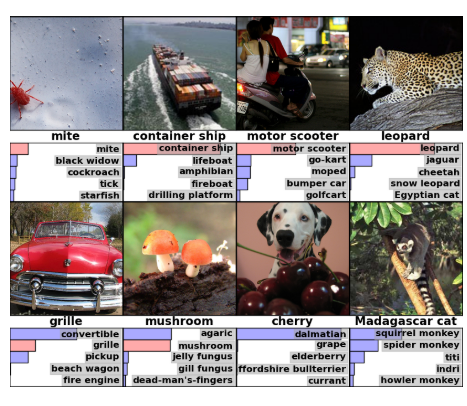
- top-1 error rate:对于测试集的每张图片,预测输出1000维的向量,其中最大的值对应的类别即为预测的类别,和真实类别比较的错误率
- top-5 error rate:对于测试集的每张图片,预测输出1000维的向量,其中最大的top-5个值对应的类别即为预测的类别,如果包含真实类别,就算预测正确,否则错误,由此计算的错误率
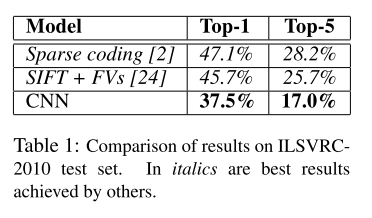
- 2010年,也就是ILSVRC竞赛举办的第一年,作者就参加了
- 这是测试集结果,ILSVRC-2010 测试集标签公开
- 表中第一行、第二行是其他人的方案取得的最好结果
- 第一行:在不同特征上训练的稀疏编码模型,预测结果取平均
- 第一行:在 Fisher Vector 上训练的两个分类器,预测结果取平均,其中Fisher Vector由两种类型的稠密采样特征计算得到
- 这些方案不是端到端的
- 表中第三行,当时他们的方案就是CNN
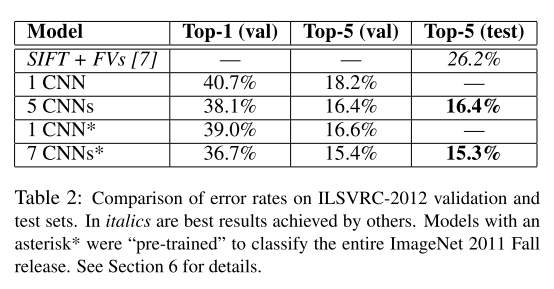
- ILSVRC-2012 测试集标签不公开,所以从训练数据划出了一部分验证集
- 第一行其他人的方案,ILSVRC-2012 第二名
- 第二行:本文描述的CNN架构
- 第三行:5个CNN模型,预测结果取平均
- 第四行(*表示使用了预训练):1个CNN + extra sixth convolutional layer over the last pooling layer
- 在整个 ImageNet 2011 Fall Release(15M images, 22K categories)上预训练,然后 fine-tuning on ILSVRC-2012
- 第五行(*表示使用了预训练):2个CNN + 第三行的5个CNN
- 前2个CNN在整个 ImageNet 2011 Fall Release(15M images, 22K categories)上预训练,然后 fine-tuning on ILSVRC-2012
- 使用不同的激活函数,神经网络预测错误率下降速度对比
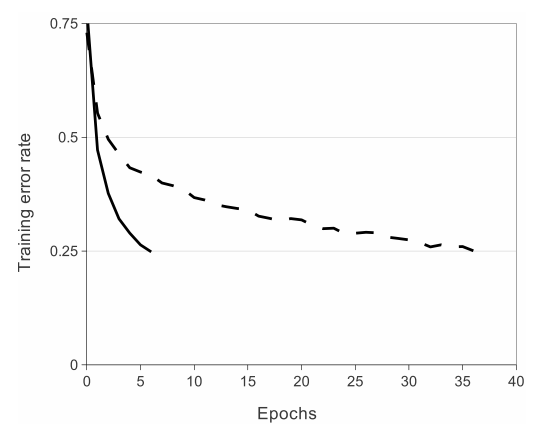
- 一个4层的卷积神经网络,在CiFAR-10上训练,虚线是使用 tanh 激活函数,实线是用 ReLU 激活函数
- 使用 ReLU 激活函数比 tanh 快6倍,后一个激活函数计算量大
- 模型学到了什么?
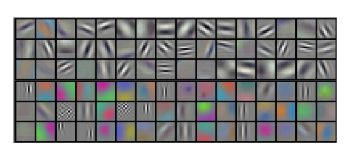
- 上图每行16个grid,共6行,每个grid代表一个kernel
- 前三行的结果是
conv1在第一块GPU48个卷积核的可视化效果,color-agnostic - 后三行的结果是
conv1在第二块GPU48个卷积核的可视化效果,color-specific - 作者说这种特殊现象在每次运行期间都会发生,与特定的随机初始化权重方法无关
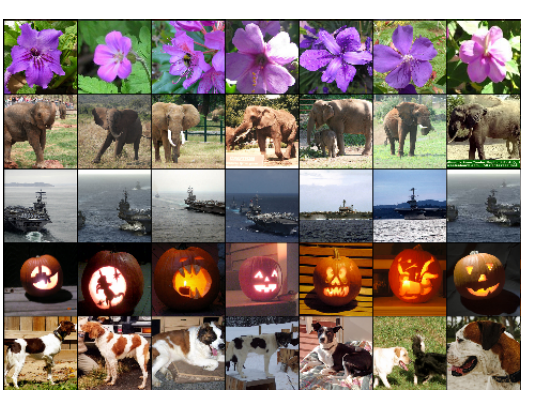
- 上图第1列的图片来自测试集;剩余的6列来自训练集,并且有如下关系
- 这些测试集、训练集的图片,经过AlexNet 最后一个 hidden layer 产生的特征向量,Euclidean distance最小
PyTorch 实现
- 定义
AlexNet网络结构import torch import torch.nn as nn class AlexNet(nn.Module): def __init__(self, num_classes=1000): super(AlexNet, self).__init__() self.features = nn.Sequential( nn.Conv2d(3, 96, kernel_size=11, stride=4, padding=2), nn.ReLU(inplace=True), nn.MaxPool2d(kernel_size=3, stride=2), nn.Conv2d(96, 256, kernel_size=5, padding=2), nn.ReLU(inplace=True), nn.MaxPool2d(kernel_size=3, stride=2), nn.Conv2d(256, 384, kernel_size=3, padding=1), nn.ReLU(inplace=True), nn.Conv2d(384, 384, kernel_size=3, padding=1), nn.ReLU(inplace=True), nn.Conv2d(384, 256, kernel_size=3, padding=1), nn.ReLU(inplace=True), nn.MaxPool2d(kernel_size=3, stride=2), ) self.classifier = nn.Sequential( nn.Dropout(), nn.Linear(256 * 6 * 6, 4096), nn.ReLU(inplace=True), nn.Dropout(), nn.Linear(4096, 4096), nn.ReLU(inplace=True), nn.Linear(4096, num_classes), ) def forward(self, x): x = self.features(x) x = torch.flatten(x, 1) x = self.classifier(x) return x def alexnet(pretrained=False, progress=True, **kwargs): """ Args: pretrained (bool): If True, returns a model pre-trained on ImageNet progress (bool): If True, displays a progress bar of the download to stderr """ model = AlexNet(**kwargs) if pretrained: state_dict = load_state_dict_from_url(model_urls['alexnet'], progress=progress) model.load_state_dict(state_dict) return model - 定义一些对图片的操作,在加载数据时应用这些操作
import torchvision.transforms as transforms transform = transforms.Compose([ transforms.Resize(256), transforms.CenterCrop(224), transforms.ToTensor(), transforms.Normalize(mean=[0.485, 0.456, 0.406], std=[0.229, 0.224, 0.225]), ]) - 准备训练图片、测试图片、标签数据
import torchvision train_data = torchvision.datasets.ImageNet( root='./data', train=True, download=True, transform=transform ) trainloader = torch.utils.data.DataLoader( train_data, batch_size=4, shuffle=True, num_workers=2 ) test_data = torchvision.datasets.ImageNet( root='./data', train=False, download=True, transform=transform) testloader = torch.utils.data.DataLoader( test_data, batch_size=4, shuffle=False, num_workers=2 ) with open('image_classes.txt') as f: classes = [line.strip() for line in f.readlines()] - 【可选】对数据进行可视化
import matplotlib.pyplot as plt import numpy as np # function to show some random images def imshow(img): img = img / 2 + 0.5 # unnormalize npimg = img.numpy() plt.imshow(np.transpose(npimg, (1, 2, 0))) plt.show() # get some random training images dataiter = iter(trainloader) images, labels = dataiter.next() # show images imshow(torchvision.utils.make_grid(images)) # print labels print(' '.join('%5s' % classes[labels[j]] for j in range(4))) - 准备AlexNet模型,并查看模型结构
model = alexnet() # check model architecture or description model.eval() - 【可选】对某些数据集,需要改变物体类别数目、全连接层输入/输出维度,
# updating the second classifier model.classifier[4] = nn.Linear(4096,1024) # updating the third and the last classifier # that is the output layer of the network. model.classifier[6] = nn.Linear(1024,10) - 设置使用
GPU/CPU设备# initializing a device device = torch.device("cuda:0" if torch.cuda.is_available() else "cpu") print(device) # move model to the specified device model.to(device) - 定义损失函数、优化器,开始训练 AlexNet
import torch.optim as optim # set loss function criterion = nn.CrossEntropyLoss() # set optimizer optimizer = optim.SGD(model.parameters(), lr=0.001, momentum=0.9) # loop over the dataset multiple times epochs = 90 for epoch in range(epochs): running_loss = 0.0 for i, data in enumerate(trainloader, 0): # get the inputs; data is a list of [inputs, labels] inputs, labels = data[0].to(device), data[1].to(device) # zero the parameter gradients optimizer.zero_grad() # forward + backward + optimize output = model(inputs) loss = criterion(output, labels) loss.backward() optimizer.step() # print statistics running_loss += loss.item() if i % 2000 == 1999: # print every 2000 mini-batches print('[%d, %5d] loss: %.3f' % (epoch + 1, i + 1, running_loss / 2000)) running_loss = 0.0 print('Finished Training of AlexNet') - 测试刚刚训练的 AlexNet
# testing Accuracy correct = 0 total = 0 with torch.no_grad(): for data in testloader: # move input images and labels to specified device images, labels = data[0].to(device), data[1].to(device) outputs = model(images) _, predicted = torch.max(outputs.data, 1) total += labels.size(0) correct += (predicted == labels).sum().item() print('Accuracy of the network on the 10000 test images: \ %d %%' % (100 * correct / total))